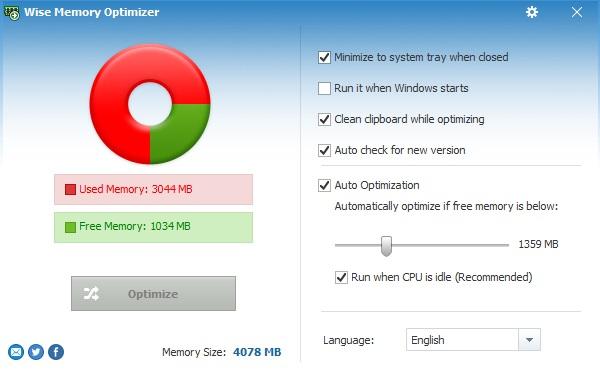
- Wise memory optimizer turn off requests how to#
- Wise memory optimizer turn off requests full#
- Wise memory optimizer turn off requests free#
- Wise memory optimizer turn off requests windows#
For instance, if your cubes are small and don’t have many rules/feeders it may be more beneficial to leave this off. feeders file and allow TM1 to re-generate the file.Īlthough this is a greater feature, judgment is required on when to use it. Therefore, even if you remove a particular feeder from the rule file it will remain in the.

In many cases start-up time can be significantly reduced, examples of a 80-90% reduction are common.įeeders are saved to the. It is best practice to activate persistent feeders if you have large cubes which have an extensive number of fed cells. feeders files and will re-load the feeders for cubes. Upon server startup the tm1 server will reference the. feeders file for each cube that has rules. When you active persistent feeders, it will create a. This all happens automatically when it needs to - there’s no point in slowing things down by forcing it to happen before it’s necessary.Persistent Feeders allows you to improve the loading of cubes with feeders, which will also improve the server start-up time.
Wise memory optimizer turn off requests windows#
If Windows needs RAM, it will push data to the page file or discard cached data, anyway.
Wise memory optimizer turn off requests how to#
RELATED: PC Cleaning Apps are a Scam: Here's Why (and How to Speed Up Your PC) This makes no sense! All it accomplishes is selling you another system optimization program you don’t need.
Wise memory optimizer turn off requests free#
In other words, these programs free up fast memory by forcing data you need onto slower memory, where it will have to be moved back to fast memory again.

Any memory being used for cache may be discarded, so Windows will have to get the data it needs from the hard drive. However, all this does is slow things down - now the applications you use will have to get the data they need from the page file, reading from the hard drive and taking longer to work. They then deallocate the memory, leaving it empty.īoth of these tricks will indeed free up RAM, making it empty.
Wise memory optimizer turn off requests full#
In the past, full RAM did indicate a problem. The RAM is being used as a cache, but it’s still marked as available for any program that needs to use it.

Notice that very little RAM is actually “free” in the screenshot below. If it’s full, there’s a good chance it can help speed up program loading times and anything else that would use your computer’s hard drive. There’s no point in having RAM sit empty - if it’s empty, it’s being wasted. Even if your RAM is completely full and your computer needs more of it to run an application, your computer can instantly discard the cached data from your RAM and use that space for the application. RELATED: Why It's Good That Your Computer's RAM Is FullĬrucially, there’s no point in having RAM empty. When you need the data again, your computer doesn’t have to hit your hard drive - it can just load the files from RAM. Whether it’s copies of web pages you had open in your browser, applications you previously opened, or any other type of data you might need again soon, your computer hangs onto it in its RAM. Instead, your computer uses your RAM to cache data for faster access. That 3 GB of used RAM doesn’t necessarily indicate waste.

In reality, modern operating systems are pretty good at managing memory on their own. That can be surprising to some people - look how bloated modern versions of Windows are! How are you ever going to run additional programs with so little memory available? You may look at your computer’s RAM and see it filling up - for example, you may have 4 GB of RAM and see that 3 GB is full with only 1 GB to spare. Memory optimizers are based on a misunderstanding. Is Your Computer’s RAM Filling Up? That’s Good!


 0 kommentar(er)
0 kommentar(er)
